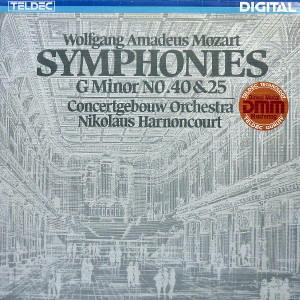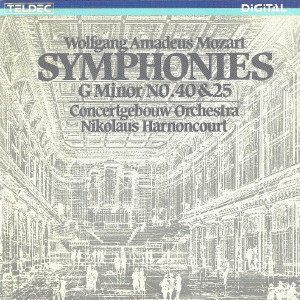 |
1 LP -
6.42935 AZ - (p) 1983
|
 |
| 1 CD -
8.42935 ZK - (c) 1984 |
|
| Wolfgang
Amadeus Mozart (1756-1791) |
|
|
|
|
|
|
|
| Symphonie Nr. 40 g-moll, KV
550 |
|
32' 39" |
|
- Molto allegro
|
6' 39" |
|
A1 |
- Andante
|
12' 22" |
|
A2 |
- Menuetto: Allegretto
|
3' 48" |
|
A3 |
- Allegro assai
|
9' 50" |
|
A4 |
Symphonie
Nr. 25 g-moll, KV 183 (473dB)
|
|
26' 43" |
|
- Allegro con brio
|
10' 32" |
|
B1 |
| - Andante |
5' 31" |
|
B2 |
| - Menuetto |
3' 30" |
|
B3 |
| - Allegro |
7' 10" |
|
B4 |
|
|
|
|
| CONCERTGEBOUW ORCHESTRA,
AMSTERDAM |
|
| Nikolaus
Harnoncourt, Dirigent |
|
|
Luogo
e data di registrazione
|
Concertgebouw,
Amsterdam (Olanda) - giugno 1983
|
|
Registrazione
live / studio
|
| studio |
Producer
/ Engineer
|
-
|
Prima Edizione CD
|
| Teldec
- 8.42935 ZK - (1 cd) - 59' 22" - (c)
1984 - DDD |
Prima
Edizione LP
|
Teldec - 6.42935
AZ - (1 lp) - 59'
22"
- (p) 1983 - Digital
|
|
|
Notes
|
Apart from a lost
early work in A minor, K. 183 and
K.550 are the only symphonies in a
minor key that Mozart wrote. Both
works are so characterized by pathos,
drama and grief that, despite the
great chronological and internal
difference between them, even thematic
similarities can be found. The
dominant impression, however, is one
of an irreconcilable contrast, The fifteen
years that lie between the work
of the17-year-old composer and the
penultimate symphony of the mature man
were years of incomparable development.
The “little” G minor symphony K.l83
was completed in Salzburg on 5th
October 1773, two days after the B
flat major symphony K.l82, which has a
number of features in common with its
sister work, particularly in the
dramatic character of the Hrst
movement and the gentle, soothing mood
of the slow movement (in E flat major
and with muted strings in both works).
The acuter character of themes,
movements and whole works, dramatic
modulations and contrasts and a
particular intensity of detail here
and in the symphonies K.20l and 202,
which followed at the beginning of 1774,
can most probably be traced back to
the influence of some of Haydn’s
so-called “Sturm und Drang”
symphonies, which Mozart became
acquainted with during
his stay in Vienna in the summer of 1773.
(One should observe that the term
“Sturm und Drang” is misleading, since
in both Haydn’s and Mozart’s case it
is more a question of extreme emotions
than an externalized subjectivity.)
The G
minor symphony seems to
have been particularly influenced by Haydn’s
E minor work the
“Trauersymphonie”.
Admittedly, a comparison also
immediately reveals the basic
difference: marked compositional logic
in Haydn and Mozart’s
undisguisedly theatrical techniques of
progression, intensification and
contrast, inspired by opera and making
use of operatic cadence. In the outer
movements - both of them sonata
movements with a regular repeat -
these techniques, in the service of a
drastic depiction of emotion, lead to
the introduction of new themes in the
development which, like the exposition
subjects, are typical emotive
gestures, scarcely structures in their
own right. In both
movements, the intensification of the
emotional language also leads to coda
formations in which the movements are
energetically summarized and which are
thus both the most original and the
most operatic sections - the operatic
tone is at its most striking in the
quasi recitative conclusion of the
finale. The andante - as in most of
the symphonies written in these years
- is more personal than these
impressive but not terribly individual
movements. The gentle elegiac mood of
the andante is lent a darker colouring
by the soloistic treatment of these
bassoons, and is plunged almost into
tragedy by momentary phrases in the
minor. The minuet likewise produces a
more personal impression: its main
section (with a theme that points
forward to the main subject of the
finale) is played out with a fair
degree of expansiveness and contrast,
and the wind scoring of the G major
trio is reminiscent of Baroque
traditions.
Th ejump from K.l83 to
K.55o is a leap from quasi-operatic
depiction of emotions to a new kind of
instrumental dramatics, from energetic
and inspired imitation to an
originality which defies analysis.
Mozart put the work down on paper at
the end of July 1788,
one month after the E flat major
symphony K.543, and two weeks before
the “Jupiter” symphony K.55l.
It differs from its two sister works
in the absence of trumpets and
timpani, which accords with the
character of the key. There were
originally no clarinets either, but
Mozart later added these, presumably
for a specific
performance (this, however, cannot be
documented) -
appropriate alternations in the oboe
parts and in details of the slow
movement were made at the same time.
There can hardly be any doubt that
Mozart’s last three symphonies were
conceived as an “opus” of works that
complement each other through contrast.
The choice of the three keys, which
suggest three marked and conflicting
sentiments, may have been inspired by
Haydn’s first three “Paris” symphonies
(nos. 82-84), which were published in
Vienna in 1787.
Standing between the solemnity and
grace of the E flat major work and the
heroic pathos of the “Jupiter”
symphony, the G minor symphony K.550
is the dark centre of the triad, the
most dramatic of the three pieces -
it is no mere coincidence that it
opens with a subject vibrating with
agitation that is taken from
Cherubino’s “Non so piů.
And just as in “Figaro” the emotional
language of the dramatis personae was
individualized by singularity of the
musical invention, so here the
traditional G minor pathos (which is
still present in details that recall
K. 183) is individualized to an
instrumental “speech” that is
incomparably rich, incornparably
precise and unrepeatably personal. In
the outer movements - particularly at
the beginning of the development
sections - it mounts to an ardour of
such intensity that the formal order
almost breaks asunder. In the andante
(here as in K. l83 in E flat major) it
relaxes into a melancholy song
sustained by the chromatic melodies
and harmonics of late Mozart. In the
minuet, whose G major trio represents
the only completely relaxed, amicable,
indeed bucolic moment in the whole
work, it condenses into a dark pathos
intensified by a concentration of
counterpoinr. At the
same time the instrumental “speech”
causes the four movements to appear as
the four parts of a drama that
culminates in the finale and develops
towards this finale, anticipating the
formal concept of the “Jupiter”
symphony. Neither previously nor
subsequently did Mozart write an
instrumental work comparable to this
symphony, this drama, above all this
finale: it is the very utmost that
could be expressed in the musical
language of Viennese Classicism.
Ludwig
Finscher
Translation: Clive R. Williams
|
|
Nikolaus
Harnoncourt (1929-2016)
|

|

|
|